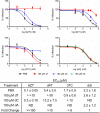SAMHD1 has differential impact on the efficacies of HIV nucleoside reverse transcriptase inhibitors
- PMID: 24867973
- PMCID: PMC4136039
- DOI: 10.1128/AAC.02745-14
SAMHD1 has differential impact on the efficacies of HIV nucleoside reverse transcriptase inhibitors
Abstract
Sterile alpha motif- and histidine/aspartic acid domain-containing protein 1 (SAMHD1) limits HIV-1 replication by hydrolyzing deoxynucleoside triphosphates (dNTPs) necessary for reverse transcription. Nucleoside reverse transcriptase inhibitors (NRTIs) are components of anti-HIV therapies. We report here that SAMHD1 cleaves NRTI triphosphates (TPs) at significantly lower rates than dNTPs and that SAMHD1 depletion from monocytic cells affects the susceptibility of HIV-1 infections to NRTIs in complex ways that depend not only on the relative changes in dNTP and NRTI-TP concentrations but also on the NRTI activation pathways.
Copyright © 2014, American Society for Microbiology. All Rights Reserved.
Figures



Similar articles
-
SAMHD1 specifically affects the antiviral potency of thymidine analog HIV reverse transcriptase inhibitors.Antimicrob Agents Chemother. 2014 Aug;58(8):4804-13. doi: 10.1128/AAC.03145-14. Epub 2014 Jun 9. Antimicrob Agents Chemother. 2014. PMID: 24913159 Free PMC article.
-
Anti-HIV host factor SAMHD1 regulates viral sensitivity to nucleoside reverse transcriptase inhibitors via modulation of cellular deoxyribonucleoside triphosphate (dNTP) levels.J Biol Chem. 2013 Jul 12;288(28):20683-91. doi: 10.1074/jbc.M113.472159. Epub 2013 Jun 5. J Biol Chem. 2013. PMID: 23744077 Free PMC article.
-
Molecular mechanism by which the K70E mutation in human immunodeficiency virus type 1 reverse transcriptase confers resistance to nucleoside reverse transcriptase inhibitors.Antimicrob Agents Chemother. 2007 Jan;51(1):48-53. doi: 10.1128/AAC.00683-06. Epub 2006 Nov 6. Antimicrob Agents Chemother. 2007. PMID: 17088490 Free PMC article.
-
Intracellular interactions between nucleos(t)ide inhibitors of HIV reverse transcriptase.AIDS Rev. 2005 Apr-Jun;7(2):113-25. AIDS Rev. 2005. PMID: 16092505 Review.
-
Biochemical and mechanistic basis for the activity of nucleoside analogue inhibitors of HIV reverse transcriptase.Curr Top Med Chem. 2004;4(10):1035-44. doi: 10.2174/1568026043388358. Curr Top Med Chem. 2004. PMID: 15193137 Review.
Cited by
-
Select host restriction factors are associated with HIV persistence during antiretroviral therapy.AIDS. 2015 Feb 20;29(4):411-20. doi: 10.1097/QAD.0000000000000572. AIDS. 2015. PMID: 25602681 Free PMC article.
-
SAMHD1 specifically affects the antiviral potency of thymidine analog HIV reverse transcriptase inhibitors.Antimicrob Agents Chemother. 2014 Aug;58(8):4804-13. doi: 10.1128/AAC.03145-14. Epub 2014 Jun 9. Antimicrob Agents Chemother. 2014. PMID: 24913159 Free PMC article.
-
Differential regulatory activities of viral protein X for anti-viral efficacy of nucleos(t)ide reverse transcriptase inhibitors in monocyte-derived macrophages and activated CD4(+) T cells.Virology. 2015 Nov;485:313-21. doi: 10.1016/j.virol.2015.08.006. Epub 2015 Aug 29. Virology. 2015. PMID: 26319213 Free PMC article.
-
Increased SAMHD1 transcript expression correlates with interferon-related genes in HIV-1-infected patients.Med Microbiol Immunol. 2019 Oct;208(5):679-691. doi: 10.1007/s00430-018-0574-x. Epub 2018 Dec 18. Med Microbiol Immunol. 2019. PMID: 30564919
-
The Dynamic Interplay between HIV-1, SAMHD1, and the Innate Antiviral Response.Front Immunol. 2017 Nov 10;8:1541. doi: 10.3389/fimmu.2017.01541. eCollection 2017. Front Immunol. 2017. PMID: 29176984 Free PMC article. Review.
References
-
- Diamond TL, Roshal M, Jamburuthugoda VK, Reynolds HM, Merriam AR, Lee KY, Balakrishnan M, Bambara RA, Planelles V, Dewhurst S, Kim B. 2004. Macrophage tropism of HIV-1 depends on efficient cellular dNTP utilization by reverse transcriptase. J. Biol. Chem. 279:51545–51553. 10.1074/jbc.M408573200 - DOI - PMC - PubMed
-
- Lahouassa H, Daddacha W, Hofmann H, Ayinde D, Logue EC, Dragin L, Bloch N, Maudet C, Bertrand M, Gramberg T, Pancino G, Priet S, Canard B, Laguette N, Benkirane M, Transy C, Landau NR, Kim B, Margottin-Goguet F. 2012. SAMHD1 restricts the replication of human immunodeficiency virus type 1 by depleting the intracellular pool of deoxynucleoside triphosphates. Nat. Immunol. 13:223–228. 10.1038/ni.2236 - DOI - PMC - PubMed
-
- Baldauf HM, Pan X, Erikson E, Schmidt S, Daddacha W, Burggraf M, Schenkova K, Ambiel I, Wabnitz G, Gramberg T, Panitz S, Flory E, Landau NR, Sertel S, Rutsch F, Lasitschka F, Kim B, Konig R, Fackler OT, Keppler OT. 2012. SAMHD1 restricts HIV-1 infection in resting CD4+ T cells. Nat. Med. 18:1682–1687. 10.1038/nm.2964 - DOI - PMC - PubMed
Publication types
MeSH terms
Substances
Grants and funding
- AI100890/AI/NIAID NIH HHS/United States
- GM103368/GM/NIGMS NIH HHS/United States
- R21 AI079801/AI/NIAID NIH HHS/United States
- AI076119/AI/NIAID NIH HHS/United States
- R01 AI058864/AI/NIAID NIH HHS/United States
- R01 AI100890/AI/NIAID NIH HHS/United States
- AI099284/AI/NIAID NIH HHS/United States
- P50 GM103368/GM/NIGMS NIH HHS/United States
- AI058864/AI/NIAID NIH HHS/United States
- R33 AI079801/AI/NIAID NIH HHS/United States
- AI079801/AI/NIAID NIH HHS/United States
- R37 AI076119/AI/NIAID NIH HHS/United States
- R01 AI099284/AI/NIAID NIH HHS/United States
- R21 AI112417/AI/NIAID NIH HHS/United States
- R01 AI076119/AI/NIAID NIH HHS/United States
- R01 AI067059/AI/NIAID NIH HHS/United States
- AI112417/AI/NIAID NIH HHS/United States
LinkOut - more resources
Full Text Sources
Other Literature Sources
Research Materials
Miscellaneous

